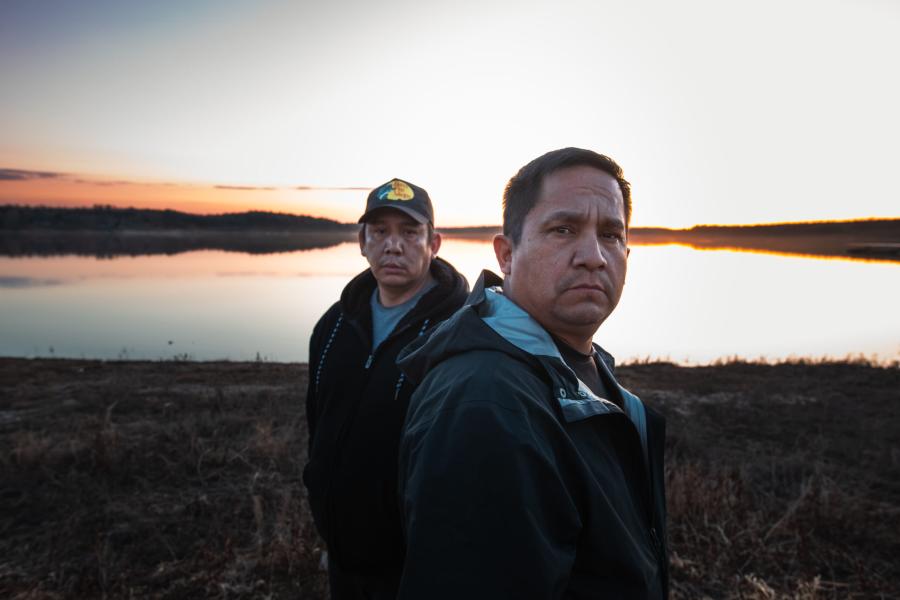Arctic Son
A film by Andrew Walton. Big Mouth Films, April 2006
Broadcast on the PBS program POV August 2007
The story of Arctic Son could not be simpler: a father attempts to reconnect with his long-estranged son. Yet like the Buddhist epigraph that opens the film—“Before enlightenment, chop wood and carry water; after enlightenment, chop wood and carry water”—its simple frame encompasses deep meaning.
The father in the film is Stanley Njootli, a Vuntut Gwitchin man who lives in Old Crow, a remote, roadless town of 300 people north of the Arctic Circle in the Yukon Territory. He still lives a largely traditional life based on hunting and fishing. His son, Stanley Jr., has grown up with his white mother in urban Washington state. He is a loutish young man with a foul mouth, a dull wit, and a blank expression, spending most of his time drinking too much and hanging out in bars and malls. As the movie opens, Stanley Jr. is getting ready to go visit his father in the north, and his father is feeling anxious about his son’s reaction.
The cultural and personal differences between them couldn’t be greater, and there is a great deal of tension as Stanley Jr. comes to grips with life in Old Crow. From his point of view there is nothing to do, and to make matters worse, the town is dry (although he does manage to find some home-brewed liquor and gets badly drunk). He is abusive and abrasive at every turn. His stoic, long-suffering father senses that the boy needs some tough love, so he takes his son on an expedition to his cabin in the bush. Any lingering romanticism about traditional indigenous life the viewer might have is quickly extinguished as the snowmobiles break down repeatedly and the Njootlis wrestle their equipment over broken terrain and thin ice on their long trek to the rustic cabin by a river. As Stanley Jr. quickly learns, life here is tenuous and entirely self-sustained. There are dozens of ways to die, not the least of which is starvation. Stanley Sr. tells his son that if they want to eat they will need to catch some fish or kill a caribou, and the bulk of the movie is devoted to the pair’s attempts to do just that. Over the course of weeks, the boy learns how to chop holes in the ice and string an underwater net, track caribou, set snares, and skin rabbits. But mostly he learns how to chop wood and carry water.
Slowly, almost imperceptibly, we sense a change in the young man as he settles into bush life. He is less sullen, swears a little less, and starts to do chores by his own volition rather than out of grudging obligation. By the end of their stay in the bush, he is fundamentally different, although he isn’t aware of it yet. Shortly after coming back to Old Crow, Stanley Jr. returns to Washington. He expects to slip back into his old life, and he does get together with his friends, but it’s clear he no longer has anything in common with them. In one striking scene a slacker friend is driving him to the local mall to hang out. The friend is chattering mindlessly about nothing, while Stanley sits and looks out the window, clearly uncomfortable.
The pivot point of the film comes after he’s been home a few days. He is sitting outside a friend’s house smoking a cigarette. His friend has gone back into the house to get the liquor, and Stanley is saying to himself, “I’m not having as much fun as I’m supposed to.” As he stares into the camera you can almost hear the mental tumblers falling into place. The next scene shows him landing back in Old Crow, and the final scene features Stanley Jr. happily working a job as a disc jockey at the village radio station, playing rap music.
The film is remarkable for its narrative economy and its elegiac beauty, but most of all for its unsentimental depiction of indigenous life. Life in the Arctic is hard and getting harder. Poverty and desperate improvisation are the main themes of daily life. We have an uncomfortably intimate view of the father and son’s fights, the son’s drinking and swearing, the father’s imminent despair as he begins to fear the whole project was a bad idea. But the film is all the more affecting for its honesty, and the happy ending all the happier for being hard won. The underlying message of the film, too, is made stronger by its lack of sentiment: indigenous culture, however compromised, has the power to redeem identity, even in the most lost of souls.



